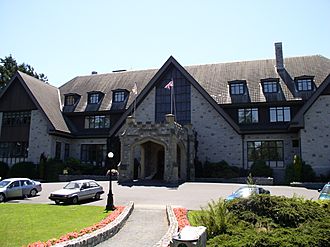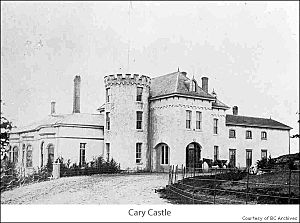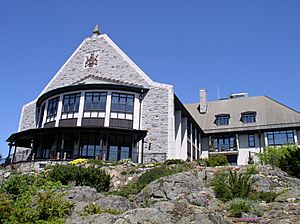Government House (British Columbia) facts for kids
Quick facts for kids Government House |
|
|---|---|

Main façade of Government House
|
|
| General information | |
| Architectural style | Modern Tudor revival |
| Location | 1401 Rockland Avenue Victoria, British Columbia V8S 1V9 |
| Coordinates | 48°25′06″N 123°20′33″W / 48.418464°N 123.342434°W |
| Construction started | 1957 |
| Client | The Queen in Right of British Columbia (Elizabeth II) |
| Owner | The Queen in Right of British Columbia (Elizabeth II) |
| Technical details | |
| Structural system | Steel frame and reinforced concrete |
| Official name: Estate of the Lieutenant Governor of British Columbia National Historic Site of Canada | |
| Designated: | 2002 |
Government House of British Columbia is a very special building. It's the official home for the Lieutenant Governor of British Columbia. This person represents the King or Queen of Canada in British Columbia. People sometimes call it "the Ceremonial Home of all British Columbians."
You can find Government House in Victoria, the capital city. It sits on a large property that's about 14.6 hectares (or 36 acres). While similar buildings in other countries are often in the middle of the city, Government House in Victoria is a bit hidden. This makes it feel more like a private home.
Contents
The Story of Government House
Early Homes for Governors
The first building used as a governor's home in this area was called Cary Castle. It was built in 1860 by George Hunter Cary. Five years later, in 1865, the British Crown bought it. They used it for the Governor of Vancouver Island. The first governor to live there was Arthur Kennedy.
In 1866, the colonies of British Columbia and Vancouver Island joined together. The old Government House in New Westminster was no longer needed. So, Cary Castle became the official home for the new united colony's Governor. From 1871, it became the home for the provincial Lieutenant Governor.
Fires and New Beginnings
Sadly, the beautiful Cary Castle and everything inside it were destroyed by a fire in May 1899. But a new building was quickly planned. Famous architects Francis Rattenbury and Samuel Maclure designed it. This new house was finished in 1903.
A very important visitor came to this house in 1939. King George VI, along with his wife, Queen Elizabeth, stayed there. They were on a big tour across Canada.
But history repeated itself. This second Government House also burned down on April 15, 1957. The current Government House was started soon after. It was finished on May 19, 1959, by a company called John Laing & Sons.
Furnishing the New Home
The new home needed furniture. The Lieutenant Governor at the time, Frank Mackenzie Ross, bought many pieces in the United Kingdom. He then gave them to the Crown for the house. Other items were also donated by people from British Columbia.
A National Historic Site
In 2002, something special happened. Thanks to the efforts of Lieutenant Governor Iona Campagnolo, Government House and its beautiful gardens became a National Historic Site of Canada. This means it's a very important place in Canadian history. A special plaque was put up by Campagnolo on October 2, 2002, to mark this honor.
What Happens at Government House?
Important Events and Visitors
Government House is a busy place! When members of the Canadian Royal Family visit Victoria, they are often welcomed and stay here. Important visitors from other countries also come to Government House.
Many special events take place here. For example, provincial awards are given out. New members are welcomed into the Order of British Columbia, which is a very high honor. There are also many lunches, dinners, parties, and speeches.
One popular event is the Lieutenant Governor's New Year's Day party. Many people from Victoria come to celebrate the holiday season.
The Lieutenant Governor's Role
The Lieutenant Governor also performs important duties here. They officially start elections by "dropping the writs of election." They also swear in new members of the Executive Council of British Columbia, who are like the provincial cabinet. And they meet with the Premier, who is the head of the provincial government.
Who Owns and Manages It?
The property belongs to the Queen in Right of British Columbia. This means it's held in trust for future Kings and Queens. It cannot be sold unless the Lieutenant Governor agrees, with advice from the Executive Council of British Columbia.
A group called the British Columbia Government House Foundation helps manage the residence. This is a non-profit group started in 1987. Their job is to make sure the property and buildings are well-maintained. They also help get British Columbia artwork for the house. They manage official gifts and help people learn about Government House's history and importance.
The foundation has special trustees. These include the Lieutenant Governor and other important people. There are also trustees chosen from different parts of society, like art, gardening, history, and law.
Inside and Out: Architecture and Design
The Building's Look
The current Government House has a T-shape and four levels, including a basement. It's built with a strong steel frame. The outside looks like a Modern version of Tudor revival style. This style is inspired by old English Tudor homes.
The walls are made of beautiful blue, grey, and pink British Columbia granite. It also has special stone trim. The roof is very tall, like a chalet, with steep slopes and many windows sticking out, called dormer windows.
Above the Ballroom's south window, you can see a carving of the Royal Arms of British Columbia. From this window, you get a great view of Ross Bay and the Strait of Juan de Fuca. On a clear day, you can even see the Olympic Mountains in Washington state!
Entering the House
The main entrance is in the middle of the north side of the building. It's under a covered driveway called a porte cochère. This part was actually from the previous Government House. It was inspired by Francis Rattenbury's own Hatley Castle.
Inside, you enter the main hall. The walls are covered in oak wood. You'll see paintings of past Lieutenant Governors and their wives. There are also large portraits of Queen Elizabeth II and Prince Philip, Duke of Edinburgh.
A grand staircase goes up to the second floor. Along the stairs, you can see the shields of different members of the Royal Family and Governors General of Canada who have visited.
The Rogers Window
The entrance hall has a very high ceiling. The tall north wall features a stunning stained glass window called the Rogers Window. It was created to celebrate British Columbia's history as a parliamentary democracy and constitutional monarchy. It also honors the Lieutenant Governors and their spouses. The window shows symbols of the King or Queen, natural emblems of British Columbia, and historical items. This beautiful window was first shown on May 2, 1990.
Rooms for Gatherings
The biggest room in Government House is the ballroom. It takes up the entire south side of the building. It's very tall, about 12 meters (40 feet) high, with a balcony around it. Three sparkling crystal chandeliers hang from the ceiling.
Artwork in the ballroom includes the Millennium Windows, finished in 2006. There's also a large textile artwork called Reflections at Government House. It shows the view from the ballroom's south window.
Other rooms for entertaining include the main dining room. It looks like the original design from the 1903 house. It has fir wood panels and a dining set from Scotland. The drawing room also reminds you of the old house.
For smaller events, there's the little drawing room, sometimes called the French Drawing Room. It has French furniture, including a special clock and vases. Two other rooms are named after the architects of the second Government House. The Maclure room has an Arts and Crafts style with handmade furniture. The Rattenbury room is a smaller dining room on the second floor. It has a table and chairs that belonged to the architect himself!
The mansion also has many art pieces in the Crown collection. These include works by British Columbia First Nations artists, specially created for the Lieutenant Governor.
Exploring the Gardens and Grounds
Government House sits on a large property of about 14.6 hectares (36 acres). These grounds are open to the public! Volunteers from the Friends of Government House Gardens Society take care of them. The community often uses the gardens, except when security is needed.
The property has many different garden areas. Each area has its own type of plants or garden style. For example, the British Columbia native plant garden has species found only in the province. The Cottage Garden is informal, with a mix of pretty flowers and plants you can eat.
There are also gardens that grow flowers for cutting, herbs, and an orchard with apple, plum, and quince trees. You can find a rock garden cared for by the Heather Society of Victoria. There are also gardens for iris, lily, rhododendron, and rose flowers. One formal Victorian rose garden is even based on the design of a garden at Warwick Castle in England!
You'll also find water features like the fountain pond and the duck pond. A very special part of the grounds is an 8.9-hectare (22-acre) Garry Oak ecosystem. This is a unique natural area.



